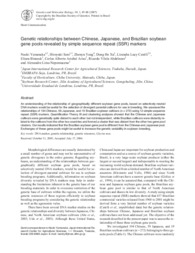Genetic relationships between chinese, japanese, and brazilian soybean gene pools revealed by simple sequence repeat (SSR) markers.
Genetic relationships between chinese, japanese, and brazilian soybean gene pools revealed by simple sequence repeat (SSR) markers.
Autoria: YAMANAKA, N.; SATO, H.; YANG, Z.; XU, D. H.; CATELLI, L. L.; BINNECK, E.; ARIAS, C. A. A.; ABDELNOOR, R. V.; NEPOMUCENO, A. L.
Resumo: An understanding of the relationship of geographically different soybean gene pools, based on selectively neutral DNA markers would be useful for the selection of divergent parental cultivars for use in breeding. We assessed the relationships of 194 Chinese, 59 Japanese, and 19 Brazilian soybean cultivars (n = 272) using 12 simple sequence repeat (SSR) markers. Quantification Theory III and clustering analyses showed that the Chinese and Japanese cultivars were genetically quite distant to each other but not independent, while Brazilian cultivars were distantly related to the cultivars from the other two countries and formed a cluster that was distant from the other two gene pool clusters. Our results indicated that the Brazilian soybean gene pool is different from the Chinese and Japanese pool. Exchanges of these gene pools might be useful to increase the genetic variability in soybean breeding.
Ano de publicação: 2007
Tipo de publicação: Artigo de periódico
Unidade: Embrapa Soja
Palavras-chave: Soja
Observações
1 - Por padrão são exibidas publicações dos últimos 20 anos. Para encontrar publicações mais antigas, configure o filtro ano de publicação, colocando o ano a partir do qual você deseja encontrar publicações. O filtro está na coluna da esquerda na busca acima.
2 - Para ler algumas publicações da Embrapa (apenas as que estão em formato ePub), é necessário ter, no celular ou computador, um desses softwares gratuitos. Sistemas Android: Google Play Livros; IOS: iBooks; Windows e Linux: software Calibre.
Acesse outras publicações
Acesse a Base de Dados da Pesquisa Agropecuária (BDPA) para consultar o acervo completo das bibliotecas da Embrapa.

